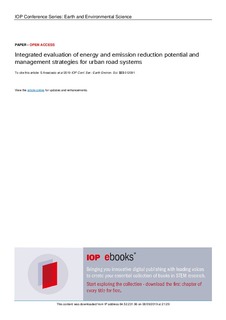Integrated evaluation of energy and emission reduction potential and management strategies for urban road systems
| dc.contributor.author | Anastasio, Sara | |
| dc.contributor.author | Wu, Shaopeng | |
| dc.contributor.author | Bohne, Rolf André | |
| dc.contributor.author | Passer, Alexander | |
| dc.contributor.author | Spaun, Sebastian | |
| dc.contributor.author | Kristensen, Terje | |
| dc.contributor.author | Li, Jiashuo | |
| dc.contributor.author | Xie, Jun | |
| dc.contributor.author | Kreiner, Helmuth | |
| dc.contributor.author | Hoff, Inge | |
| dc.contributor.author | Barbieri, Diego Maria | |
| dc.contributor.author | Vignisdottir, Hrefna Run | |
| dc.contributor.author | Lau, Albert | |
| dc.contributor.author | Amirkhanian, Serji N. | |
| dc.date.accessioned | 2019-11-26T06:37:58Z | |
| dc.date.available | 2019-11-26T06:37:58Z | |
| dc.date.created | 2019-11-22T13:34:51Z | |
| dc.date.issued | 2019 | |
| dc.identifier.issn | 1755-1307 | |
| dc.identifier.uri | http://hdl.handle.net/11250/2630401 | |
| dc.description.abstract | Abstract. Solving the problems of high energy consumption and high emissions generated by the urban road systems is of great importance for the construction of low-carbon cities. Several tools have been developed to establish a method to evaluate the carbon emission related to the life cycle of road pavements. However, the lack of key basic data such as energy consumption, pollutants and carbon emissions, and accurate management policies have hindered the transition of urban roads to clean, low-carbon systems. The HERMES project aims to compile long-term dynamic inventory of urban road energy consumption and environmental emissions and build a life cycle model. The Data Envelopment Analysis model will be used to predict the energy saving and emission reduction potential of urban roads depending on the technological solution, establish a multi-criteria evaluation system that includes energy, environment, and economic parameters, identify the best available technological solution in different cities, and propose a more targeted and effective clean low-carbon management policies. The study will provide an accurate understanding of the environmental impact of urban roads in China and Europe, evaluate the potential for energy saving and emission reduction, and provide theoretical data and decision-making reference for a clean, low-carbon transition. | nb_NO |
| dc.language.iso | eng | nb_NO |
| dc.publisher | IOP Publishing Ltd. | nb_NO |
| dc.relation.ispartof | SUSTAINABLE BUILT ENVIRONMENT CONFERENCE 2019 (SBE19 Graz) | |
| dc.rights | CC BY 3.0 | * |
| dc.rights.uri | https://creativecommons.org/licenses/by/3.0/ | * |
| dc.title | Integrated evaluation of energy and emission reduction potential and management strategies for urban road systems | nb_NO |
| dc.type | Conference object | nb_NO |
| dc.type | Journal article | nb_NO |
| dc.type | Peer reviewed | nb_NO |
| dc.description.version | publishedVersion | nb_NO |
| dc.rights.holder | © The authors | nb_NO |
| dc.subject.nsi | VDP::Teknologi: 500 | nb_NO |
| dc.source.pagenumber | 1-9 | nb_NO |
| dc.source.volume | 323 | nb_NO |
| dc.source.journal | IOP Conference Series: Earth and Environmental Science (EES) | nb_NO |
| dc.source.issue | 012091 | nb_NO |
| dc.identifier.doi | 10.1088/1755-1315/323/1/012091 | |
| dc.identifier.cristin | 1751037 | |
| cristin.unitcode | 7401,30,30,0 | |
| cristin.unitname | Infrastruktur | |
| cristin.ispublished | true | |
| cristin.fulltext | original | |
| cristin.qualitycode | 1 |
Tilhørende fil(er)
Denne innførselen finnes i følgende samling(er)
-
Publikasjoner fra CRIStin - SINTEF AS [5801]
-
SINTEF Community [2248]

